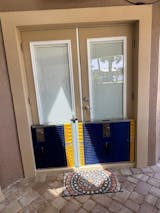Water is a precious resource, but when it touches our electric appliances, it can spell disaster. Water damage is a significant threat to the functionality and safety of electronic devices, and in flood-prone areas, it becomes even more critical to protect your appliances. In this article, we will explore why water damage is dangerous for electric appliances, how it can happen, and what steps you can take to prevent it. We'll also discuss how to protect your electric appliances from flooding, including the use of flood barriers and flood gates.
The Mechanics of Water Damage
Water and electricity don't mix well. Water is a fantastic conductor of electricity, and when it comes into contact with electronic components, it can cause serious problems. Here's why water damage is so dangerous for electric appliances:
1. Short Circuits: Water can create short circuits by bridging connections between circuits that shouldn't be connected. This can lead to overheating, fires, and permanent damage to sensitive components.
2. Corrosion: Water contains minerals and impurities that can cause corrosion when they interact with metal parts inside electronic devices. Corrosion gradually weakens connections and components, leading to reduced functionality and eventual appliance failure.
3. Circuit Board Damage: Many appliances have intricate circuit boards. Water damage can cause these boards to short out or become corroded, making the device inoperable.
4. Risk of Fire: In severe cases, water damage can lead to electrical fires, posing a significant safety risk. Water can create sparks and heat when it touches live electrical components, potentially igniting surrounding materials.
5. Mold and Mildew: Water damage can create a damp environment inside the appliance, promoting the growth of mold and mildew. These fungi can damage internal components and release allergens into the air when the appliance is in use.

Common Causes of Water Damage to Electric Appliances
Understanding the causes of water damage is crucial for prevention. Here are some common scenarios where water damage can occur:
1. Accidental Spills: Accidents happen, and a spilled drink on a laptop or phone can result in immediate water damage.
2. Flooding: Natural disasters like floods or heavy rain can inundate homes and damage appliances that come into contact with water.
3. Leaky Roofs or Plumbing: Roof leaks or plumbing issues can lead to slow, unnoticed water damage over time, affecting the appliances below.
4. Humidity and Condensation: High indoor humidity levels can lead to condensation forming on the internal components of appliances, causing long-term damage.
Preventing Water Damage to Electric Appliances
Prevention is key. Here are some tips to help safeguard your electric appliances:
1. Be Cautious with Liquids: Keep drinks away from electronics, and use spill-proof containers when necessary.
2. Seal Windows and Doors: Properly seal your home to prevent rainwater from infiltrating. Regularly inspect your roof and plumbing for leaks.
3. Use Dehumidifiers: Maintain a healthy indoor humidity level to prevent condensation within your appliances.
4. Keep Appliances Away from Water Sources: Position appliances like washing machines and dishwashers away from areas prone to leaks or flooding.
5. Invest in Waterproof Storage: Consider using waterproof cases or containers for portable electronics when using them in wet environments.
Protecting Electric Appliances from Flooding
Now, let's delve into protecting your electric appliances specifically from flooding:
1. Elevate Appliances: Whenever possible, raise your appliances above the expected flood level using platforms or stands. This helps reduce their vulnerability to floodwaters.
2. Waterproofing and Sealing: Invest in flood shields, barriers, or flood gates to prevent water from entering and damaging critical appliances.
3. Unplug and Relocate: In anticipation of a flood, unplug your appliances and move them to higher ground or an upper floor to minimize the risk of electrical damage.
4. Install Check Valves: Use check valves on your plumbing to prevent floodwaters from backing up into your home through drains and sewage systems.
5. Secure Outdoor Units: Anchor and elevate outdoor appliances like air conditioning units or generators to prevent them from being swept away or submerged.
6. Sump Pumps: Consider installing a sump pump in your basement or crawl space to remove water buildup and mitigate flood damage.
7. Waterproof Storage: Store important items, including documents and electronics, in waterproof containers or bags to protect them during a flood.
8. Insurance Coverage: Ensure that your insurance policy covers flood damage to appliances, and consider purchasing additional flood insurance for added protection.
9. Regular Maintenance: Keep your appliances in good condition by conducting regular inspections and addressing any maintenance issues promptly.
10. Emergency Kit: Prepare an emergency kit with essentials like flashlights, batteries, a portable phone charger, and a battery-powered weather radio to help you during a flood-related power outage.
Conclusion
Water damage and flooding are real threats to the safety and functionality of your electric appliances. By understanding the risks, being cautious, and taking proactive steps, you can extend the lifespan of your appliances and reduce the risk of electrical hazards in your home. Whether it's preventing water damage or safeguarding against flooding with flood barriers and flood gates, these measures will help you protect your valuable devices and maintain peace of mind in challenging circumstances.
$949.00
DAM EASY® FLOOD GATE - DOOR DAM Floods are becoming more common around the world. What was once a 100-year phenomenon is now a seasonal trend that homeowners must deal with. That’s EXACTLY why you need this Dam Easy Flood… Read MoreFlood Barrier Door Dam - Ultimate Flood Gate



















